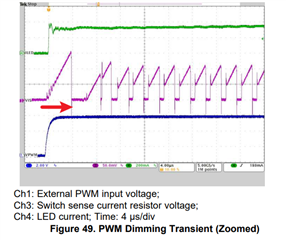Tool/software:
Hi Team,
Customers are evaluating the TPS92692-Q1 on its EVM, and for the tested waveform showed in datasheet, customers have below questions:
As the below figure showed in datasheet, when using external PWM dimming, the first NMOS turn on time after the rising edge of VPWM is longer than the static ones.
Customers would like to know why the first Ton time is longer and why the current through the Ris is also higher? And how can they calculate the first Ton time and peak current that might flow through the NMOS in first period? Customers might need the method to confirm the time in their design.

BR,
Manu


